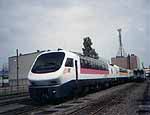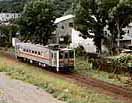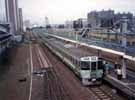
KiHa261 on 'Super Soya' Wakkanai-Sapporo service, approachs
Minami Wakkanai.
Peter Dibben, September 2001.
Diesel Multiple Units
The majority of the Hokkaido passenger network is served by diesel
multiple units.
 |
|
KiHa261 on 'Super Soya' Wakkanai-Sapporo service, approachs
Minami Wakkanai. |
The most numerous
(147 cars) express DMUs are the class 183 units,
which are not however based at Naebo but at Sapporo and Kushiro depots.
Various formations are used ranging from four to nine cars, some with
green cars. There are two different cab styles and liveries making up
the main sub classes:
Ki ha 183-1 and
183-200 have cockpit cabs without gangways, the
upper sides are white, the lower sides light grey with purple and light
green stripe under windows.
Ki ha 183-100 and
183-1500 have normal cabs with gangways, and are
branded HET (Hokkaido Experimental Train). The body sides are white
with purple and light green stripes under windows but with doors and
cab fronts painted mid blue.
These work the following services:
'Ohotsuku' Sapporo - Abashiri
'Sarobetsu' Sapporo - Wakkanai
'Tokachi' Sapporo - Obihiro
'Ozora' Sapporo - Kushiro
'Hokuto' Sapporo - Hakodate
Perhaps the most
interesting formations are those used on some
overnight trains where the formations are split and a sleeping car
(type su ha ne fu 14) is inserted.
These operate
between Sapporo and Abashiri ('Ohotsuku') and to
Wakkanai ('Rishiri'). The overnight services between Sapporo and
Kushiro have two cars inserted, a su ha ne fu 14 plus an o ha ne 24.
All these sleeping cars are painted to match the diesel unit's livery.
 |
|
'North Rainbow Express', at Naebo depot. |
Another special
set, the green liveried 3-car 'Mount Lake Onuma',
is based at Hakodate and is used on sightseeing services to the Lake
Onuma and Mount Onuma area. This is designated type ki ha 84. The 5-car
'Tomamu Sahoro Express' and the 4-car 'Furano Express' sets were
not observed on the 2001 Summer tour but a similarly styled driving car
in gold livery was seen in the scrap line at Naebo works.
The class 283 units
are similar in appearance to the class 261 in
having stainless steel bodies with blue painted sections at the ends of
the cars with the raised cabs or passenger doors. These are also
tilting units and carry the brand name 'Furico' which is Japanese for
pendulum. This fleet of 43 cars operates from Sapporo depot on the
following services:
'Super Hokuto' Sapporo - Hakodate (7 cars)
'Super Ozora' Sapporo - Kushiro (6 or 9 cars)
'Super Tokachi' Sapporo - Obihiro (6 or 9 cars)
The 27 cars of class 281 based at Hakodate depot also work 'Super
Hokuto' services, but in 7- or 8- car formations. These have stainless
steel body sides with a green, blue and red design at the doors and
blue cockpit cab fronts with gangways. These cars date from 1994 and
are branded 'HEAT Hokkaido Experimental Advanced Train'.
Hokkaido local services are operated by DMUs of several classes.
The largest fleet
is the ki ha 40 single units. These are in the
standard livery of pale grey with lilac and green stripes. A few are
however in special liveries which include ends painted to represent a
crab and a fox. This fleet differs from those based elsewhere in having
smaller windows and is made up of subclasses ki ha 40-300, 400 and 700
and totals 146 cars.
 |
|
Kiha 40 and 150 |
 |
|
Kiha 54 leaves Minami Wakkanai for Wakkanai |
The Gakuen-toshi
line to the north of Sapporo is operated mainly by
the ki ha 141 series of single ended cars. This fleet of 44 cars are
unique to Hokkaido and were converted in 1989 from o ha fu 51 loco
hauled coaches at the Naebo works.
As noted in Bullet-in 40 the type ki ha 130 used on the Hidaka line was
withdrawn from service in 2001.
The remaining DMU
type are the 3-car ki ha 201 units which are
stainless steel with green and blue stripes. These are similar in style
and can operate with the 731 type EMUs. They operate around Sapporo
between Otaru and Iwamizawa and Chitose.
Electric Traction
Not much of Hokkaido's railway is electrified. The two areas that are,
use the same 20,000 V ac 50 Hz system as found in the north of Honshu.
One electrified
section is the main line from the Seikan tunnel to
Hakodate. ED 79 electric locomotives hauling blue coaches from the type
50 series provide the 'Kaikyo' passenger services through the tunnel
between Hakodate and Aomori. Many of these are branded with characters
from the Doraemon cartoon series as part of a promotional campaign.
Eight out of the thirty-three ED 79s have a large Doraemon cat face
decorating their front ends. The coaches run in several different
formations and include some cars with carpet areas for students to
lounge on and others with toys and ball pools for much younger children.
The other daytime
service through the tunnel is the 'Hatsukari'
provided by JR East. These also operate from Hakodate to Aomori with
some running through to Morioka to provide a direct connection with the
Tohoku Shinkansen. These are operated by some six-car 'renewal' type
485 EMUs (3000 subclass) with restyled cockpit cabs, a distinctive
white and purple livery and branded 'North East Express'.
There are also sleeper services between Hokkaido and Honshu.
Sapporo - Aomori 'Hamanasu'
Sapporo - Ueno 'Hokutosei'
Sapporo - Ueno 'Erumu'
Sapporo - Ueno 'Cassiopeia'
Sapporo - Osaka 'Twilight Express'
Hakodate - Osaka 'Nihonkai'
Those starting from
Sapporo are diesel hauled (one or two DD 51s) as
far as Hakodate where ED 79s take over for the run through the tunnel
as far as Aomori. Beyond Aomori these trains are handed over to a JR
East EF 81. These services use type 24/25 sleeping cars except for the
special Cassiopeia set which is type E26/E27. Not all the cars used on
these services are based in Hokkaido. Most of the sleeping cars are in
the blue livery and the DD 51s are painted to match. The exceptions are
the Cassiopeia's silver livery and the green Twilight Express coaches.
The second
electrified area is isolated from the Hakodate area.
Hence the diesel haulage for the sleeper services. From Sapporo, this
electrified area extends Westwards to Otaru, South East to Chitose,
Chitose Airport and Muroran, and Northwards to Asahikawa.
The hourly 'Super
White Arrow' electric express service, between
Sapporo and Asahikawa is operated by type 785 units. These five
four-car and five two-car units, like all the Sapporo area electric
units, are based at Sapporo depot to the west of Sapporo station. The
livery is stainless steel with a dark grey band at window level and
purple and green stripes below.
Type 781 units also
operate between Asahikawa and Sapporo. Their
services however reverse at Sapporo to provide a through service to
Chitose Airport. 12 four-car units provide this 'Lilac', 'Suzuran'
and 'Airport' group of services. These units are very similar in body
style to the normal 481 family but have a different formation with two
separate power cars with their own pantographs instead of a linked
pair. The most noticeable body side difference is a grille behind the
driver's cab door. Livery is light grey with lilac stripes.
 |
|
721 EMU at Naebo (Sapporo) station. |
The type 731 is
very similar in appearance to the ki ha 201 diesel
units with which they can work in multiple. Apart from the presence or
absence of a pantograph, the easiest recognition feature is that the
nineteen electric units carry red and green stripes while the diesel
units have blue and green stripes.
The type 721
carries only the green stripe but differs from the 731
by having deeper cab windows and not having flush fitted passenger
windows. The type 711 carries a red livery with cream stripe and has a
cab style similar to their 1,500 V dc type 111 cousins. As with many
Hokkaido types they have smaller windows than those operating elsewhere
and have the further distinction of single leaf sliding doors. Most
cars have two doors per side but a few driving cars have three.
Steam and other operations
Steam operations in Hokkaido are in charge of two 2-6-4T locomotives, C
11 171 and C 11 207. These operate over various routes the most well
known being Fukagawa ? Mashike (Suzuran) and Sapporo ? Rankoshi
(Niseko), other routes are Asahikawa ? Nayoro and Asahikawa ? Furano.
The small fleet of coaches to work these trains includes vehicles from
types 14, 33, 42, and 44. The formation in use during the 2001 summer
tour was:
C 11 171, o ha 14-519, o ha 14-526, su ha tsu 44-1, su ha fu 14- 505,
yo 4647, DE 15 1535.
Yo 4647 is of
course a freight brake van but was nevertheless
available to ride in. The brown liveried o ha 14 coaches still retain
their cast iron heating stoves. The DE 15 was provided in order to
pilot the train back from Mashike where there are no run-round
facilities. The DE 15 type is usually associated with snowploughs and
this was no exception, the mounting points for the ploughs being
clearly visible. Twenty-one type DE 15 are based in Hokkaido. Other
Diesel locomotives owned by JR Hokkaido are the eight DE 10 used mainly
for shunting and the type DD 51 referred to earlier.
 |
|
Open coach Torokko converted from a four wheel wagon. |
Freight
JR Freight also operates on Hokkaido. Nine freight ED 79 are based at
Goryokaku (one station out of Hakodate) depot to haul trains, usually
in pairs, through the Seikan tunnel. A duty that is shared with the
type EH 500 based at Sendai. Diesel traction is necessary north of
Goryokaku and through trains are handed over to either a 'Red Bear'
DF 200 or a pair of DD 51. Most freight is containerised with the main
terminals at Goryokaku, Sapporo, Higashi-Muroran and Obihiro being
served by Super liner 100 km/h trains.
The Hokkaido Freight Diesel fleet has its main depot at Washibetsu near Higashi-Muroran and comprises 19 x DF 200, 52 x DD 51 and 10 x DE 10.
Private Railways
UPDATE - This railway closed on 21st
April 2006.
There is one
private railway on Hokkaido, the Chihoku Kogen Tetsudo,
which runs from Kitami to Ikeda where some services run through to
Obihiro over the JR tracks and attached to JR DMUs. The single unit
railcars on this line are of two types. There are 8 x CR70 and 4 x
CR75. One of the CR75 cars is an 'Event' car with carpets and Karaoke
and available for private hire.